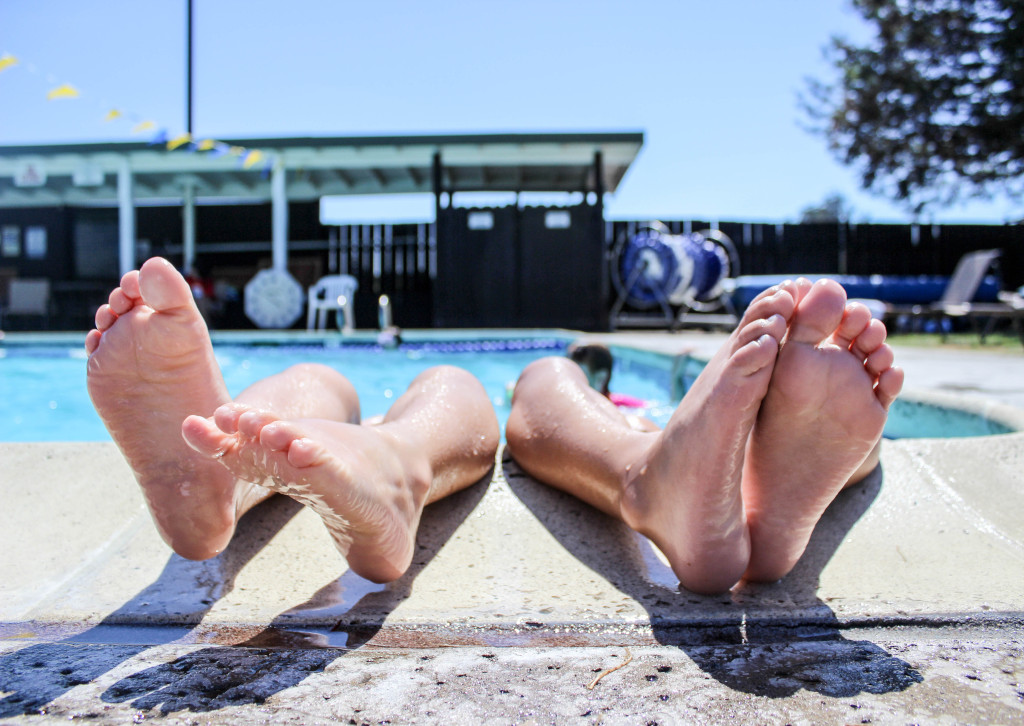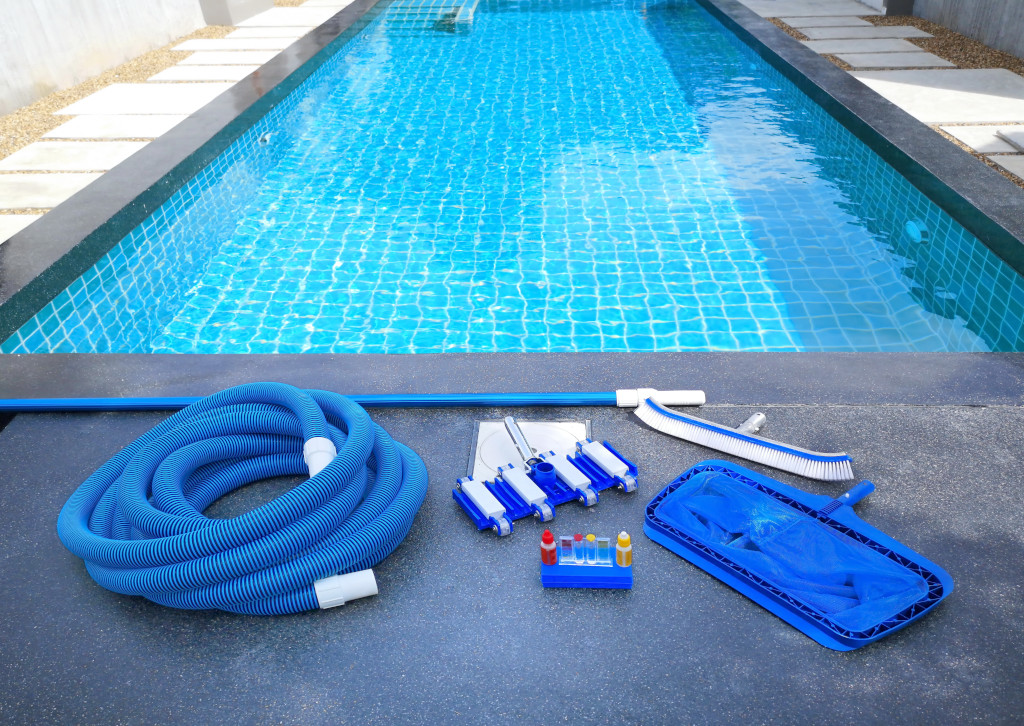
Most homeowners choose to have a swimming pool in their home to enjoy family gatherings, parties, or just pure relaxation. There are even more positive reasons than these to own a pool, but the key is keeping the oasis in such a way as to minimize the pool maintenance burden and amount of daily pool cleaning needed.
Like all parts, they will eventually need replacement. We are referring to filter cartridges, grids, skimmers, and even the motor. However, proper care increases the life of your swimming pool and will save you money in the long run.
One of the reasons some pool owners spend more money caring for their oasis has to do with mistakes. You read right, mistakes on how to care for their pool. Here is a list of errors that may often go towards spending too much cash on repairs and your pool turning green:
Not Putting in Enough Chlorine
The more people in your swimming pool, the more chlorine it needs. There is a reason why you have a swimming pool, which is to be able to use it. But when you have a party or a gathering, it will need more chlorine to keep the chemicals in balance. Make sure to clean the pool the following day by using a brush for the tiles. Add more chlorine and clean the filter; or if your swimming pool needs more chemicals, a floater or an inline chlorinator is ideal.
Man’s Best Friend Likes the Pool Too
Man’s best friend likes the pool too, but if your canine is a long-haired retriever, make sure to net the swimming pool promptly after your pet’s swim. Furthermore, the skimmer basket needs cleaning, and you don’t want your dog’s hair back into the pool. Use water clarifiers after your dog swims in the pool. It will break down oils and other contaminants in the water.
Remember that proper maintenance prevents excessive debris or a clog.
The Pool Pump
If you want to save money on your electric bill, expect to spend more on chlorine, acid, and even professional maintenance. The truth is that swimming pools are built to keep themselves clean. The filter and skimmer will keep debris out when the pump runs correctly, preventing algae growth. However, all swimming pools are unique, so run the swimming pool pump for 8 hours per day in the summer. If your swimming pool has any signs of algae or turns from clear to green, then run it for 24 hours per day until the condition of your pool improves. It is ALL about the FLOW! Circulation IS the key to a low-maintenance swimming pool.
Not Checking Your Pool’s Chemistry Often
It’s essential to check the chemicals in your swimming pool at least twice a week during the summer. You can make minor adjustments to the water instead of significant changes that, eventually, create a hazardous activity.
Don’t Shock the Swimming Pool in Peak Sun Time
One thing is not to shock your pool weekly, and another is not to shock your pool during the day. Did you know that the sun can burn chlorine? The sun can burn one part per million per hour, creating a chloramine or dead chlorine. To do oxidation, the level of chlorine must be 13ppm or more. It is better to do the shocking process at dusk, leaving enough time to do the job.
Ignoring Calcium Hardness in a Pool
Calcium hardness is the sum of all the calcium that dissolves in your pool’s water. High calcium levels are unstable and worsen when your pool’s pH rises above normal. The result is cloudy water in your pool.
You can add chemicals to keep calcium hardness in the 200-275 ppm range for plaster and concrete pools.
Water Levels
When you overfill a pool, the backwash washes dirt and debris back into the pool and soaks your deck with water. On the other hand, if you do not fill your pool to the proper level, your pool’s pump could start filtering air instead of water and damage the pump.
To keep the pool’s water level in proportion, evaluate the evaporation and the number of swimmers in the pool.
Wearing Non-Swimsuits in the Pool
Even though most people ignore this pool care tip, everyone who swims in your pool must wear the proper swimwear.
Avoid wearing clothes made of cotton since it contains pollutants like oils, detergents, and germs, contaminating your pool. It can also be life-threatening; cotton clothing absorbs a lot of water, making it difficult to get out of the pool.
Swimsuits made from spandex or nylon are best. They are lightweight, absorb minimal water, and dry fast.
Dirty Pool Filters
If your filter is not clean, you run the risk of algae growing and accumulating in your pool, and it can lead to inadequate filtering or damage to the pump motor.
Soak dirty filters in a mild solution of hydrochloric acid. After soaking for a few minutes, rinse them off and let them dry in an open area. You must protect yourself by wearing protective clothing during this process.
Backwashing DE Pool Filter Often
Flush your diatomaceous earth filter (DE) only when necessary. Doing so daily will not allow your filter to reach its full pool cleaning potential.
Only backwash if your filter’s pressure gauge rises to 8 or 10 PSI after cleaning.
Follow the Three C’s for Easier Maintenance
Creating a cheat sheet will help you easily care for and keep your swimming pool in top shape. Don’t let the chemicals and the filter system intimidate you. After all, anything and everything needs maintenance.
First, three groups are essential: circulation, cleaning, and chemicals (The Three C’s). Let’s take a look at them:
Circulation
If there is a good water flow, then the water will stay clean. It helps even more when you do these tips:
Empty the baskets in the skimmer and keep pumps clear of all debrisPlace the return jets into an angle mode, placing them slightly down and in the same direction that will help the water spin around the pool; and will help to push the debris up to the surface, so the skimmers can grab it.Let the pump run for 8 to 12 hours per day. If you live in a warm area most of the year, let it run for a much longer time.Make sure the pressure is between 10 and 20 psi. Remember that if it goes down, then you must check your pump. Otherwise, it will not keep your pool.
Cleaning
Cleaning your swimming pool is not about the water, but also the walls and tiles. If you do not want any algae to stick to your pool walls, we recommend the following:
Skim every day; it will stop the debris from sinking to the bottom, leaving less to vacuum and preventing stains.Brush twice a week; brush everywhere in your pool, and it will prevent algae from growing.Get an automatic swimming pool cleaner, the easiest way to vacuum, and you do not have to do it. There are many of them out on the market that you can choose based on your needs.
Chemistry
The chemicals in the water keep pool cleaning clear and help avoid any algae formation or spread of any other bacteria. It is vital to have a water test kit or strips in hand. What are the chemicals?
Acid — the measurement is pH; the level must be between 7.4 and 7.6Alkaline — is a stabilizer that helps the pH level from changing drasticallyCalcium — calcium hardness prevents corrosion of equipment
Now that you know what chemicals go into preserving the water clean, this is what we recommend:
Test the water every week and that it all balances out to 7.5. You can use a water test kit or strips.Shock the pool once a week. You only need one pound of shock treatment per 10,000 gallons (ca. 37,854 l) of water. Remember to wear gloves and protective glasses when you use any chemicals.
Creating a cheat sheet will help you remember everything regarding pool care and prepare a schedule. It will help you to have your swimming pool with the best water quality and clarity.
Don’t forget that Platinum Pools has a service staff ready to assist you with any questions regarding pool maintenance. Call us today at 281.870.1600 or visit our webpage for an appointment.
The post Swimming Pool Cleaning Mistakes and How to Avoid Them appeared first on Platinum Pools.


